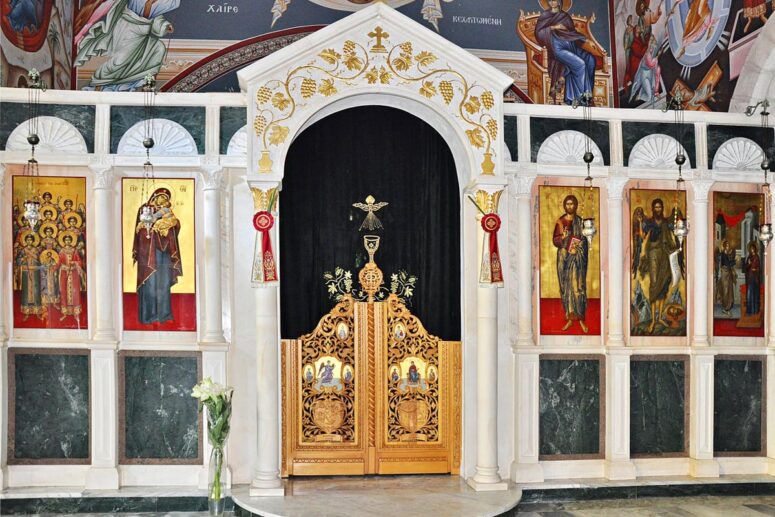
Almost every church has a curtain separating the central nave from the altar. Historically, such a curtain appeared even earlier than the actual altar barrier, which much later evolved into an iconostasis. What is the origin of the church veil? What role does it play in worship service, and what is its symboliс meaning?
The veil in the Tabernacle
The church veil (Greek καταπέτασμα) existed long before the advent of Christianity and is first described in the Old Testament. It played a very important role in the Old Testament divine serviceю Namely, it separated the Holy of Holies in the Tabernacle (and later in Solomon’s Temple), where even the high priest only had access once a year, from the sanctuary constituting the main part of the Tabernacle where the divine service actually took place. The instructions on the making and the materials for the curtain were given by God Himself, Who commanded Moses to create the Tabernacle according to the pattern seen by the prophet on the mountain during the Divine Revelation (see Ex. 25:40). The curtain of the Tabernacle was made of blue, purple and scarlet wool, as well as fine woven linen. According to the Jewish historian Josephus Flavius, such a composition of the veil represented correspondence to the four elements of the world (Ios. Flav. Antiq. 3. 7. 7). The cherubs on the veil were also embroidered at the direct God’s command, which symbolises permissibility of religious images associated with worshipping the true God.

The thickness of the altar wall in the Second Temple was approximately one cubit, resulting in the practice of hanging two curtains, one on each side of the barrier. The “Great Gate”, i.e. the gate separating the temple from the narthex, was also decorated with a curtain of the same material as the catapetasma. But instead of the cherubims, it was decorated with stars. Such embroidery was called Babylonian (Ios. Flav. Antiq. 14. 7.1). As you can see, the ancient Jews could have borrowed some ornamental motifs from the neighboring peoples. The outer curtain was usually lifted on major holidays so that people could contemplate what was happening in the sanctuary. According to the Gospels, at the very moment of Christ’s death, the altar curtain was torn in half, revealing the Holy of Holies of the Temple, which has a very important symbolic meaning, described in detail in the Epistle to the Hebrews. Numerous hymns of the Orthodox service are dedicated to this gospel episode. There is reason to believe that the veil that was torn at Easter was made by the hands of the Virgin Mary, who had been chosen for this work together with other girls (Protoevangelium of James, 10).
The veil in Christian worship
In various traditions of the East, the veil appeared no later than in the 6th century, whereas various catapetasma prayers existed in various Eastern rites. Over time, introduction of the practice separating the temple’s naos from the altar was attributed to St. Basil the Great. Some editions of his hagiography include an episode where the saint directs the hanging of the catapetasma to prevent distraction from the religious service, after he notices one of his deacons staring at a woman standing among the laity. And yet, there is no evidence pointing at the veil being used in Constantinople before the tenth century. Divine service at St Sophia did not involve the altar curtain giving people the opportunity to directly witness the beauty of the altar. There is however a distinctive type of curtain that was in use at St Sophia. Today it can only be met in Athos and rarely in other churches.
We are talking about the curtains on the ciborium, a unique canopy erected over the altar table and resting on four pillars. Such ciborium can also be observed in the most ancient temples of the Christian West, where catapetasma has not taken root at all. A ciborium usually had three or four curtains, covering the table at certain times during the service while the altar room remained open. There is an assumption that the ciborium and the altar curtains appeared and developed independently of each other starting from the 4th century. (Georgy S. Dobronravov). The veils have usually been symbolically interpreted as the Savior’s shroud (Theodor Andid. Comment. Liturg.), which points to the liturgical shroud of Christ having evolved also from the catapetasma. St. Simeon of Thessaloniki explained that the church veil symbolizes the veil of the Heavenly Tabernacle, “where there are faces of holy angels and the saints who have departed to God” (Sym. Thessal. De templ.). Russian pilgrim St Anthony of Novgorod (†1232), who once visited Constantinople, describes the ciborium curtains at St. Sofia, which shows us that practice still being used in the 13th century. In Russia, however, ciboria were only erected in city cathedrals and eventually gave way to catapetasma, as the iconostasis developed over time.

In the modern practice of the Russian Church, the veil enshrouds the altar outside the service time, except during the Bright Week period. Important services of the daily circle, such as Matins and Vespers, are accompanied by the opening of the veil, while Hours and Compline are served with the veil drawn, as well as temple services conducted by lay people. The Liturgy has its own complex scheme of closing and opening the catapetasma based on the connection between its constituent parts and the symbolism of the Savior’s life.
The veil is designed to accustom us to a reverent attitude towards the Holy of Holies of the Orthodox Church – the Mystery of the Altar, “hidden from centuries and generations, now revealed to His saints” (Col. 1:26).
You can order catapetasma and other church vestments in our Catalogue




